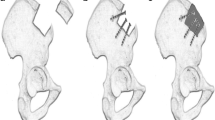Summary. Osteotomies in porotic human cadaveric humeri were fixed with metallic plates and screws in 3 experimental groups. In group I, osteotomies of the 3 arbitrarily chosen humeri were plated without reinforcement. The osteotomies of the contralateral 3 humeri were plated after reinforcement with a poly(L-lactide) augmentation device. In group II, osteotomies on one side were plated without reinforcement, but those of the contralateral humeri were plated after reinforcement with methylmethacrylate. In group III, the osteotomies of 3 humeri were plated and reinforced with poly(L-lactide) and in the 3 contralateral humeri were plated after reinforcement with methylmethacrylate. The pullout strength for screws from bones augmented with poly(L-lactide) was identical to those where methylmethacrylate had been used. The bones with poly(L-lactide) augmentation had a higher torsional stiffness than those with methylmethacrylate cement and those which were not reinforced. Resorbable polymeric medullary augmentation devices can be used to enhance plating of osteoporotic bones.
Résumé. Des humérus de cadavres humains dont le caractère osteoporotique fût déterminé par tomodensitométrie ont été osteotomisés et ostéosynthésés. Les neufs paires ont été divisées aléatoirement en 3 groupes. Dans le groupe I, l’ostéotomie fût ostéosynthésée à l’aide d’une plaque en T sans renforcement. L’humérus controlatéral était renforcé par une barre en polylactate et l’osteosynthèse fixée à l’aide d’une plaque en T. Dans le group II, l’ostéotomie fût ostéosynthésée à l’aide d’une plaque en T sans renforcement. L’humérus controlatéral était renforcé par du méthylméthacrylate et l’osteosynthèse fixée à l’aide d’une plaque en T. Dans le groupe III, l’ostéotomie fût renforcée par une barre en polylactate et l’osteosynthèse fixée à l’aide d’une plaque en T. L’humérus controlatéral était renforcé avec du méthylméthacrylate et l’osteosynthèse fixée à l’aide d’une plaque en T. La force d’arrachement des vis insérées dans l’os renforcé par le polylactate était identique à la force d’arrachement des vis insérées dans l’os renforcé par le méthylméthacrylate. Les osteotomies renforcées par la barre en polylactate avaient un moment de torsion supérieur à celles renforcées avec du ciment et aux non renforcées. Les barres en polylactate peuvent potentiellement être utilisées pour le renforcement d’os ostéoporotique.
Similar content being viewed by others
Author information
Authors and Affiliations
Additional information
Accepted: 3 July 1996
Rights and permissions
About this article
Cite this article
Mainil-Varlet, P., Cordey, J., Landolt, M. et al. The use of a resorbable augmentation device to secure plating of osteoporotic bones . International Orthopaedics SICOT 21, 217–222 (1997). https://doi.org/10.1007/s002640050154
Issue Date:
DOI: https://doi.org/10.1007/s002640050154




